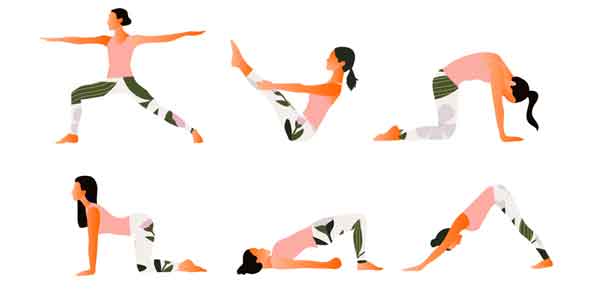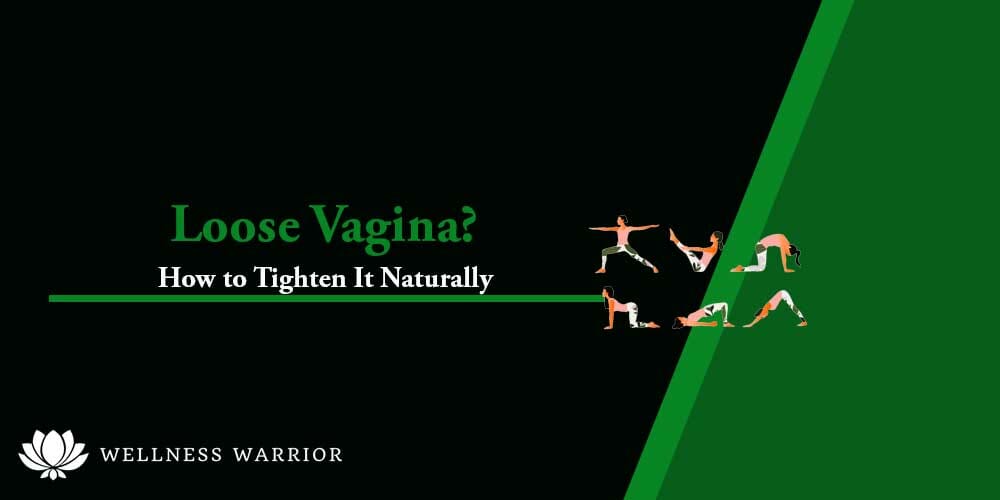Vaginal “looseness” is a controversial issue for women.
It can make women anxious and affect their confidence. Moreover, there are concerns about its impact on sexual performance.
This is not the only reason to practice maintaining reproductive health.
Vaginal tightening can have benefits on the body. Vaginal muscles or pelvic floor muscles support the vagina, vaginal walls, bladder, and rectum.
Weakened pelvic floor muscles can influence not only your sex life but also cause urinary problems.
The pelvic muscles expand and retract like a rubber band.
Hence there are natural ways you can keep your vagina tighter with different types of exercise.
To know how to perform these exercises at home properly, we will look into more details on pelvic floor muscles.
Vaginal Tightening: Simple Ways to Tighten Your Private Parts
Let’s start off by examining the causes of vaginal looseness…
Is It Possible to Have a Loose Vagina?
The vaginal muscles cannot become loose permanently.
It is elastic, which means it can accommodate things coming in or going out.
It retracts back to its size regardless of an active sexual lifestyle.
Repeated intercourse with one partner or different partners does not cause a loose vagina.
Your vagina may naturally change with childbirth. It can weaken and affect elasticity.
The vaginal walls contain elastin and collagen, which help expand to perform vaginal delivery.
The muscles expand to assist the baby through your vaginal canal during childbirth. This causes small tears, which decreases the elasticity of vaginal muscles.
However, aging process can also cause your vagina to stretch slightly.
Like the other muscles in your body, you should maintain your vaginal muscles with appropriate exercises.
This will strengthen your pelvic floor muscle function as you age or after childbirth.
Vaginal Health
Many women are seeking genital cosmetic methods to improve their genital appearance and sexual performance.
Several procedures improve vaginal tightness, which involves a range of surgical procedures performed mainly for sexual reasons.
There are several ethical and psychological issues linked to sexual health. Anatomic perfection of the vagina does not equate to satisfying sex life.
Additionally, there are vaginal rejuvenation methods that claim to change your tissues with invasive methods or laser treatment.
There are several risks and concerns for undergoing surgery for this primary purpose.
You may experience vaginal dryness, vaginal pain, or discomfort. This condition is called vaginal relaxation syndrome.
This is when vaginal laxity or “looseness” can impact a woman’s physical, mental, and sexual health.
The increase in popularity of making women’s vagina tight has given rise to baseless home remedies that can cause more harm than benefits.
People claim to tighten their vagina with topical DIY treatments successfully.
Many of these home remedies are acidic and can irritate the vaginal tissue, vulva, and labia.
This gives an illusion of a tighter vaginal canal.
In reality, these cause inflammation and pain. Instead, the pH imbalance and sugar content of these substances can cause infections.
Healthy foods are meant to be taken by mouth and not topically applied to vaginas.
Green tea and probiotic-rich foods can keep your vagina healthy if you regularly add them to your diet.
Having a baby multiple times can be stigmatized with reduced sexual performance from the vaginal changes caused by pregnancy.
However, some measures can be taken to treat it. Similarly, menopause, weight gain, and sometimes impact sports can affect the vagina.
xThe hormones influence estrogen levels which are affected by these health issues.
Moreover, menopause can decrease estrogen hormone while aging muscles and tendons can weaken pelvic floor muscles.
If you have concerns over your sexual or reproductive health, consult a medical professional to diagnose a possible illness properly.
4 Ways on How to Tighten Vaginal Walls

The pelvic floor muscles which support the vaginal walls can be damaged. If these muscles weaken they can influence your sexual performance.
Nevertheless, you can strengthen pelvic floor muscles with exercises at home.
These pelvic floor exercises can support the muscles around your pelvic organs, uterus, bladder, and rectum. A good course is the Pelvic Floor Strong program.
You can do these at home or seek a specialist as long as you perform these exercises for pelvic floor strength properly.
Your pelvis floor muscles need the same attention as much as your other muscles.
They have a considerable role in urinary continence in addition to orgasm in sex. The exercises practiced by women for vaginal tightening are the following:
1) Kegel Exercises

Kegel exercises are one of the most common pelvic floor muscle training for women.
It has introduced the concept of pelvic floor awareness on the benefits of muscle strength in the vagina.
Training your pelvic floor muscles with kegel exercises is superior to other methods such as electrical stimulation and vaginal cones.
Muscle strength is measured by vaginal pressure to determine its efficacy.
A Kegel is a contraction of the vaginal muscles by tightening the pelvic muscles. First, you need to identify which is the pelvic floor muscles.
A common technique is by pretending you need to urinate and then holding it in.
These are the muscles that control urine flow.
You can also identify the pelvic floor muscles by controlling your actual urination when you go to the bathroom.
The muscles in your vagina, bladder, or anus get tight and move up while your thighs, butt, and abdomen should remain relaxed.
When you succeed in identifying your pelvic floor, you can proceed to perform kegel exercises.
The steps in kegel exercises:
- Most people prefer lying down on their back as a position for Kegels.
- Focus on tightening your pelvic muscles.
- Inhale and relax everything, then exhale and contract your pelvic floor.
- Hold the contraction of muscles for 5 seconds
- Relax for another 5 seconds
Repeat these steps 10 times, 3 times a day. As you build up muscle strength, increase the time from 5 seconds to 10 seconds.
Remember only to tighten your pelvic floor while performing Kegels.
You will need to consistently do this exercise to keep your vaginal muscles healthy. Results will appear in just a few weeks.
Kegel exercises can lead to stronger muscles under the uterus.
Kegel exercise is also beneficial to all individuals who have problems with urine leakage or bowel control.
You will have fewer symptoms if you keep doing these exercises routinely.
However, do not increase the length and time of the activity; overdoing it can lead to straining.
2) Pelvic Tilt Exercises
Pelvic tilt exercise or pelvic floor physiotherapy is designed for the specific needs of the vagina.
It is a program tailored by a specialized physiotherapist for pelvic floor muscle function or vaginal tightening.
The intensity of the exercises will depend on your condition.
If you have just had child birth, the exercise routine will be light at first and gradually increase.
Pelvic tilt exercise steps:
- Stand with your shoulder and butt against the wall.
- Keep your knees relaxed.
- Pull your belly button inwards your spine.
- Your back should be flattened against the wall.
- Tighten your belly button for 4 seconds, then release.
Repeat this exercise routine 10 times, 5 times a day. Pelvic tilt exercises is a great way to strengthen your pelvic floor. They are part of your core and support your vaginal muscles.
3) Vaginal weights

A vaginal weight or pelvic floor weight is a tampon-sized object or cone you put in your vagina.
This weight is covered with a soft silicone cover and is inserted into the vagina. It can provide additional resistance to any type of pelvic floor exercise.
Also, a vaginal weight can be used to train greater body mass during Kegels or regular household chores for vaginal tightening.
How to use vaginal weights:
- Insert the lightest cone into your vagina.
- Squeeze your vagina’s muscles and hold them in place for about 15 minutes.
- Repeat twice a day
Increase the weight of the cone gradually as you progress with your exercise.
4) Yoga and Pilates
Yoga and Pilates can also be considered pelvic floor exercises for vaginal tightening. Both of these can cause vaginal tightening as it involves stretching the body and providing elasticity.
Your pelvic floor muscles can benefit from it.
There are yoga poses you can perform that are targeted at your vaginal muscles.
You can apply for yoga classes or inquire with an instructor about properly performing the required yoga poses.
Vaginal “looseness” is a controversial issue for women.
It can make women anxious and affect their confidence. Moreover, there are concerns about its impact on sexual performance.
This is not the only reason to practice maintaining reproductive health.
Vaginal tightening can have benefits on the body. Vaginal muscles or pelvic floor muscles support the vagina, vaginal walls, bladder, and rectum.
Weakened pelvic floor muscles can influence not only your sex life but also cause urinary problems.
The pelvic muscles expand and retract like a rubber band.
Hence there are natural ways you can keep your vagina tighter with different types of exercise.
To know how to perform these exercises at home properly, we will look into more details on pelvic floor muscles.
The Bottom Line
Your vagina is an integral part of your body.
Most women are unaware that a tight vagina can be achieved without invasive surgery or expensive laser treatment.
You can achieve vaginal tightness naturally by keeping your muscles strong with pelvic floor exercises.
The benefits of Kegels, pelvic tilts, yoga, and vaginal weights surpass sex satisfaction. They can also improve your urinary control.
Increased age and pregnancy may cause your vagina to lose its elasticity naturally.
However, these are not permanent consequences.
A few weeks after giving birth, you can achieve stronger pelvic floor muscles without needing risky procedures.
By adding these exercises to your routine, you can be more confident about your sex life.
Suppose you have additional concerns about your vaginal health. Consult your doctor about other symptoms you are experiencing.
Some underlying conditions may influence sexual performance, urinary incontinence, vaginal issues, and pain.
The information provided here is for educational purposes only. It is not meant to replace professional medical advice from a healthcare provider.
